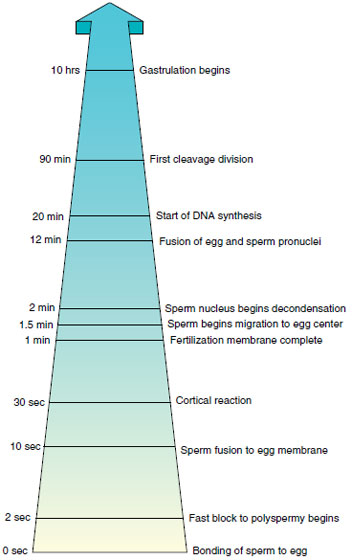Fusion of Pronuclei and Egg Activation
Fusion of Pronuclei and Egg
Activation
Once sperm and egg membranes have fused, the sperm loses its flagellum, which disintegrates. Its nuclear envelope then breaks apart, allowing the sperm chromatin to expand from its extremely condensed state. The enlarged sperm nucleus, now called a pronucleus, migrates inward to contact the female pronucleus. Their fusion forms the diploid zygote nucleus. Nuclear fusion takes only about 12 minutes in sea urchin eggs (Figure 8-6), but requires about 12 hours in mammals.
Fertilization sets in motion several important changes in the cytoplasm of the egg—now properly called a zygote —that prepare for cleavage. It serves to remove one or more inhibitors that had blocked metabolism and kept the egg in its quiescent, suspended-animation state. Fertilization is immediately followed by a burst of DNA and protein synthesis, the latter utilizing the abundant supply of messenger RNA previously stored in the egg cytoplasm. Fertilization also initiates an almost complete reorganization of the cytoplasm within which are morphogenetic determinants that will activate or repress specific genes as development proceeds. Movement of cytoplasm repositions the determinants into new and correct spatial arrangements that are essential for proper development. The zygote now enters cleavage.
Once sperm and egg membranes have fused, the sperm loses its flagellum, which disintegrates. Its nuclear envelope then breaks apart, allowing the sperm chromatin to expand from its extremely condensed state. The enlarged sperm nucleus, now called a pronucleus, migrates inward to contact the female pronucleus. Their fusion forms the diploid zygote nucleus. Nuclear fusion takes only about 12 minutes in sea urchin eggs (Figure 8-6), but requires about 12 hours in mammals.
Fertilization sets in motion several important changes in the cytoplasm of the egg—now properly called a zygote —that prepare for cleavage. It serves to remove one or more inhibitors that had blocked metabolism and kept the egg in its quiescent, suspended-animation state. Fertilization is immediately followed by a burst of DNA and protein synthesis, the latter utilizing the abundant supply of messenger RNA previously stored in the egg cytoplasm. Fertilization also initiates an almost complete reorganization of the cytoplasm within which are morphogenetic determinants that will activate or repress specific genes as development proceeds. Movement of cytoplasm repositions the determinants into new and correct spatial arrangements that are essential for proper development. The zygote now enters cleavage.
 |
| Figure 8-6 Timing of events during fertilization and early development in a sea urchin. |




